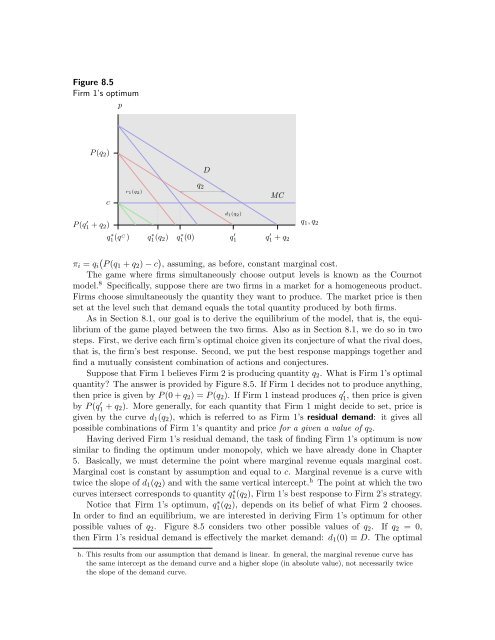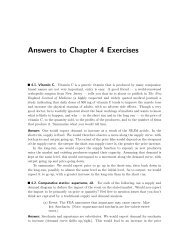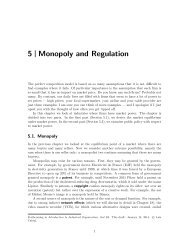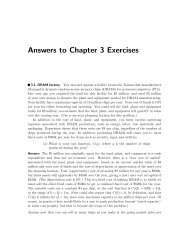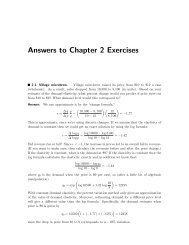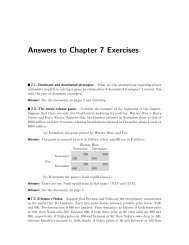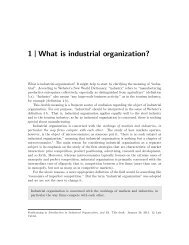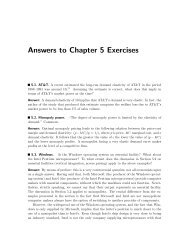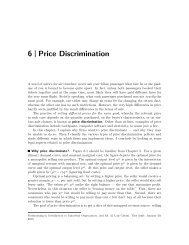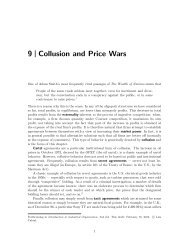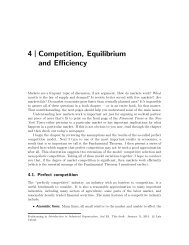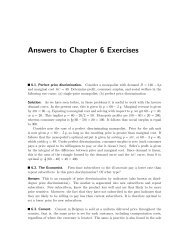8 Oligopoly - Luiscabral.net
8 Oligopoly - Luiscabral.net
8 Oligopoly - Luiscabral.net
Create successful ePaper yourself
Turn your PDF publications into a flip-book with our unique Google optimized e-Paper software.
Figure 8.5<br />
Firm 1’s optimum<br />
p<br />
P (q 2 )<br />
D<br />
c<br />
P (q ′ 1 + q 2 )<br />
r 1 (q 2 )<br />
.<br />
.<br />
.<br />
.<br />
.<br />
.<br />
.<br />
.................................................................................................................................................... ....................................................................................................................................................<br />
.<br />
.<br />
.<br />
.<br />
.<br />
.<br />
.<br />
q 2<br />
d 1 (q 2 )<br />
MC<br />
q 1 , q 2<br />
q ∗ 1(q C ) q ∗ 1(q 2 ) q ∗ 1(0) q ′ 1 q ′ 1 + q 2<br />
(<br />
π i = q i P (q1 + q 2 ) − c ) , assuming, as before, constant marginal cost.<br />
The game where firms simultaneously choose output levels is known as the Cournot<br />
model. 8 Specifically, suppose there are two firms in a market for a homogeneous product.<br />
Firms choose simultaneously the quantity they want to produce. The market price is then<br />
set at the level such that demand equals the total quantity produced by both firms.<br />
As in Section 8.1, our goal is to derive the equilibrium of the model, that is, the equilibrium<br />
of the game played between the two firms. Also as in Section 8.1, we do so in two<br />
steps. First, we derive each firm’s optimal choice given its conjecture of what the rival does,<br />
that is, the firm’s best response. Second, we put the best response mappings together and<br />
find a mutually consistent combination of actions and conjectures.<br />
Suppose that Firm 1 believes Firm 2 is producing quantity q 2 . What is Firm 1’s optimal<br />
quantity? The answer is provided by Figure 8.5. If Firm 1 decides not to produce anything,<br />
then price is given by P (0 + q 2 ) = P (q 2 ). If Firm 1 instead produces q 1 ′ , then price is given<br />
by P (q 1 ′ + q 2). More generally, for each quantity that Firm 1 might decide to set, price is<br />
given by the curve d 1 (q 2 ), which is referred to as Firm 1’s residual demand: it gives all<br />
possible combinations of Firm 1’s quantity and price for a given a value of q 2 .<br />
Having derived Firm 1’s residual demand, the task of finding Firm 1’s optimum is now<br />
similar to finding the optimum under monopoly, which we have already done in Chapter<br />
5. Basically, we must determine the point where marginal revenue equals marginal cost.<br />
Marginal cost is constant by assumption and equal to c. Marginal revenue is a curve with<br />
twice the slope of d 1 (q 2 ) and with the same vertical intercept. h The point at which the two<br />
curves intersect corresponds to quantity q1 ∗(q 2), Firm 1’s best response to Firm 2’s strategy.<br />
Notice that Firm 1’s optimum, q1 ∗(q 2), depends on its belief of what Firm 2 chooses.<br />
In order to find an equilibrium, we are interested in deriving Firm 1’s optimum for other<br />
possible values of q 2 . Figure 8.5 considers two other possible values of q 2 . If q 2 = 0,<br />
then Firm 1’s residual demand is effectively the market demand: d 1 (0) ≡ D. The optimal<br />
h. This results from our assumption that demand is linear. In general, the marginal revenue curve has<br />
the same intercept as the demand curve and a higher slope (in absolute value), not necessarily twice<br />
the slope of the demand curve.


